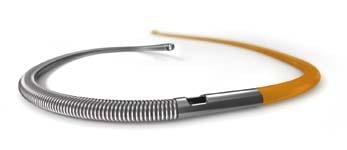
The PressureWire Aeris measures fractional flowreserve (FFR). It is one of the first wireless devices introduced to help reduce cath lab wire obstructions.
Fractional flow reserve (FFR) is starting to change cardiologists’ minds about how to treat patients since the release of two-year results from the FAME (FFR vs. Angiography in Multivessel Evaluation) trial at Transcatheter Cardiovascular Therapeutics (TCT) 2009. It showed FFR lowers costs by reducing the number of stents and produces better patient outcomes.
The FAME two-year results were highlighted as one of the “late-breaking” trials at TCT, which symposium organizers believe will have a major impact on interventional cardiology.
FFR advocates say the intravascular pressure measurement can be used to assess the functional blood flow through a stenosis. Angiography and IVUS may show a vessel to be badly occluded, but FFR can determine if the blood flow is adequate for oxygen delivery to the myocardium. This information may influence whether or not to stent the lesion. The FAME study set out to determine if there is any benefit to using FFR to guide stent therapy. Researchers believed it could reduce the number of stents used, lower potential stent-related comorbidities, and help improve patient outcomes.
FFR measures the hemodynamic significance of a stenosis, said William F. Fearon, M.D., FAME co-principal investigator and associate director of interventional cardiology at Stanford University Medical Center, Palo Alto, Calif. “The angiogram, even though it is our gold standard, can be misleading in some cases,” he said. He said the two main take-home messages from FAME are FFR helps lower costs and improves outcomes.
Two-year results of patients who had FFR-guided therapies demonstrated the risk of death or myocardial infarction (MI) was 34 percent lower than those who were treated with angiography alone (12.7 percent for the angiography-guided group compared to 8.4 percent for the FFR-guided group), he said.
The study showed patients who received FFR-guided treatment had increasingly superior outcomes over time with the two patient groups showing a difference in patient death and myocardial infarction of 3.8 percent after 12 months and 4.3 percent after two years. Results also showed only one out of 513 of deferred lesions resulted in a late myocardial infarction.
“Death and MI were significantly reduced in the FFR arm,” Dr. Fearon said.
The study also found the use of FFR did not increase average procedural times or overall procedural costs.
After one year, FFR-guided treatment showed a difference of about $2,000, or a 14 percent cost savings, between total healthcare costs for the FFR-guided cohort and the group treated by angiography alone. The study found the lower healthcare costs were a result of reduced procedural costs, reduced follow-up costs for major adverse cardiac events, and shorter hospital stays.
“It improves outcomes and lowers costs,” Dr. Fearon said. “A third fewer stents were used in the FFR arm, which significantly lowered costs beyond the costs of the FFR catheters.”
FFR catheters cost about $650, while a stent costs about $1,500 to $2,500 each.
“The two-year data from the FAME study continue to show improved outcomes when multivessel coronary stenting is guided by measurement of FFR,” Dr. Fearon said. “Use of FFR technology represents a rare opportunity in medicine, in which an innovative product not only improves clinical outcomes, but also saves money.”
Among the clinical implications of FAME is the possibility of better outcomes with PCI. Dr. Fearon said the COURAGE trial showed similar results with drug therapy vs. PCI in stable patients. However, he said if the PCI had been guided using FFR, the study would likely have tipped in favor of PCI.
The FAME study was a randomized, prospective, multicenter trial that enrolled 1,005 patients with multivessel coronary artery disease. It compared outcomes for patients whose treatment was guided by FFR to those whose treatment was guided only by angiography 12 months after receiving a stent.
The study used St. Jude Medical’s PressureWire Certus technology to measure FFR. The 12-month results from the FAME study were published in the Jan. 15, 2009, issue of the New England Journal of Medicine.
Cardiologists realize angiography does not allow them to see the whole picture when it comes to coronary lesions, and IVUS was originally adopted as an adjunct diagnostic technology to help assess lesions, said Augusto Pichard, M.D., director of cath lab, Washington Hospital Center, Georgetown University, Washington, D.C., during the TCT 2009 session “Implementing Evolving Tools for Percutaneous Coronary Interventions.” He said FFR technology emerged in the late 1990s and offered an alternative to IVUS that related functional information about vessels.
Dr. Pichard said Washington Hospital Center now uses FFR in all 11 of its cath labs. He said FFR set up takes about two to three minutes. As a general rule, he does not touch any lesions with an FFR of .8 or higher, and usually will not stent lesions between an FFR of .75 to .8.
The higher FFR values indicate an insignificant amount of stenosis, and lower values mean there is significant stenosis. An FFR value of .50 means a lesion is causing a 50 percent drop in blood pressure. Lesions with an FFR below .75 are usually considered candidates for stenting. Those above 0.75 are generally not considered culprits of angina or ischemia.
“This underscores again the limitations of angiography,” said Stephen Ellis, M.D., Cleveland Clinic Foundation, and co-author of “Strategic Approaches in Coronary Intervention,” which includes a chapter on using FFR. He said FAME highlights the need for an adjunct to angiography to verify a stent is actually needed.
FFR will not put a patient in harm’s way with a device that is not needed, said Jeffrey Popma, M.D., Beth Israel Deaconess Medical Center, Boston, who lead discussion on the trial following its presentation at TCT.
St. Jude Medical and Volcano Corp. are currently the only two companies offering FFR catheters with FDA clearance.


 April 22, 2024
April 22, 2024 








